Table of Contents
Table of Contents
Craving a bold, restaurant-quality stir-fry that’s both fiery and satisfying? Kung Pao Beef is the perfect balance of savory, spicy, and slightly sweet flavors, all wrapped in a glossy, mouthwatering sauce. With tender beef slices, crunchy peanuts, and the unmistakable tingle of Sichuan peppercorns, this dish brings the authentic taste of Sichuan cuisine straight to your kitchen.
Whether you love the heat of dried red chilies or prefer a milder kick, this easy-to-make recipe is endlessly customizable. Plus, it’s faster than takeout! Ready to master a Chinese takeout favorite that’s packed with flavor? Let’s dive in!
What is Kung Pao Beef?
Kung Pao Beef is a bold, fiery, and flavor-packed stir-fry dish that originates from Sichuan cuisine. It’s the beefy counterpart to the classic Kung Pao Chicken, featuring tender marinated beef, crunchy peanuts, and a rich, savory sauce infused with dried red chilies and Sichuan peppercorns. This dish is known for its perfect balance of spicy, sweet, and tangy flavors, creating an irresistible combination that keeps you coming back for more.
What Makes Kung Pao Beef Special?
- Authentic Sichuan Flavor – The dish gets its signature kick from dried red chilies and numbing Sichuan peppercorns, offering a unique, tingling sensation.
- Tender, Juicy Beef – Marinated in a combination of soy sauce, Shaoxing wine, and cornstarch, the beef turns irresistibly soft and flavorful.
- Savory-Sweet Sauce – A perfect mix of soy sauce, hoisin, Chinese black vinegar, and a hint of brown sugar creates a deliciously rich, umami-packed glaze.
- Quick & Easy to Make – With just 30 minutes from start to finish, Kung Pao Beef is ideal for busy weeknights without compromising on taste.
Unlike Mongolian beef, which leans towards a sweeter, soy-based profile, Kung Pao Beef delivers a punchier, spicier experience, making it a must-try for fans of bold Asian flavors. Whether you’re looking for an easy homemade takeout option or simply love the thrill of Sichuan-style heat, this dish is guaranteed to impress.
Key Benefits of Kung Pao Beef
Why should Kung Pao Beef be your next go-to recipe? Aside from its incredible flavor, this dish offers several standout benefits that make it a favorite for home cooks. Here’s why you’ll love making it:
- Quick and Easy to Make – With just a handful of ingredients and a fast stir-fry method, Kung Pao Beef comes together in under 30 minutes. No need for hours of prep – perfect for busy weeknights.
- Packed with Flavor – The combination of Sichuan peppercorns, soy sauce, hoisin sauce, and chili peppers creates a bold, savory sauce that’s both spicy and slightly sweet – a total flavor explosion.
- Customizable Heat – Whether you like it mild or fiery, you can adjust the spice level by adding or reducing the amount of dried chilies and Sichuan peppercorns. It’s the perfect dish to tailor to your taste preferences.
- Protein-Packed – Tender beef provides a satisfying protein boost, making this dish a filling, wholesome meal. Add some veggies or serve over rice or noodles for a complete meal.
- Restaurant-Quality at Home – You can recreate that Chinese takeout feel right in your own kitchen, impressing your family or guests with a dish that tastes like it’s straight from your favorite Chinese restaurant.
Kung Pao Beef is a perfect balance of spicy, savory, and crunchy, and it’s an incredibly versatile dish that’s just as perfect for a weeknight dinner as it is for a dinner party. With these key benefits, it’s easy to see why this dish is both popular and practical!
Ingredients for Kung Pao Beef
To make this flavorful Kung Pao Beef, you’ll need just a few simple ingredients that come together to create a vibrant, spicy stir-fry. Here’s what you’ll need:
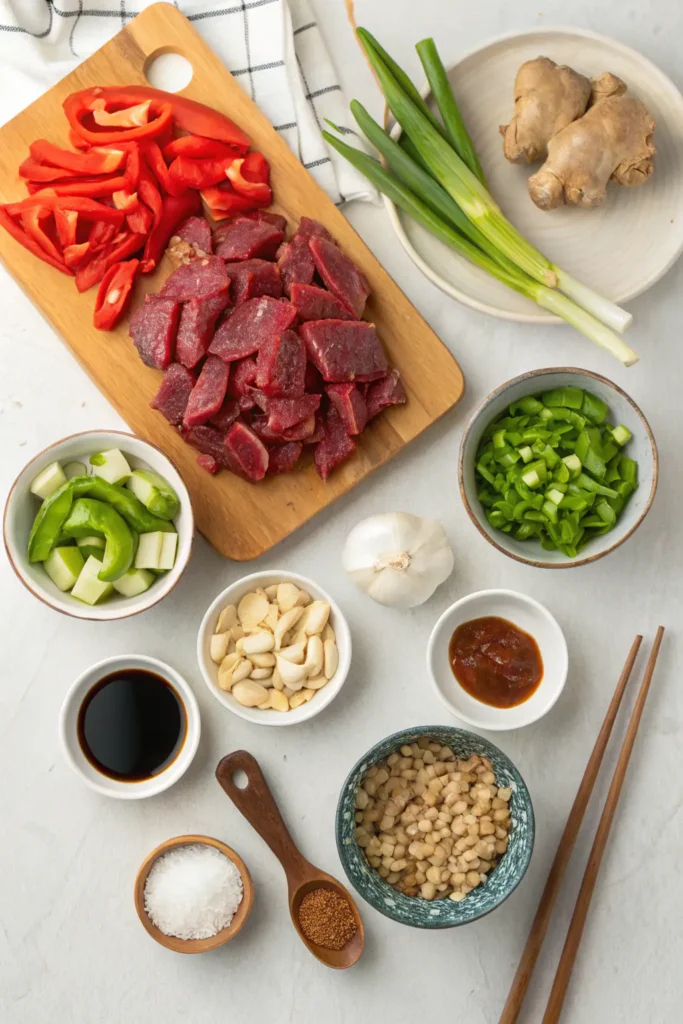
For the Marinade:
- 1 lb flank steak (or sirloin, thinly sliced against the grain)
- 2 tbsp soy sauce
- 1 tbsp rice vinegar
- 1 tbsp cornstarch
- 1 tsp sesame oil
For the Stir-Fry Sauce:
- 2 tbsp soy sauce
- 2 tbsp hoisin sauce
- 1 tbsp Chinese black vinegar (or substitute with balsamic vinegar)
- 1 tbsp sugar
- 1 tsp Sichuan peppercorns, ground (for that signature numbing flavor)
- 1 tsp chili paste (adjust to your spice preference)
- 1 tsp garlic, minced
- 1 tsp ginger, minced
For Stir-Frying:
- 2 tbsp vegetable oil (or peanut oil for an authentic touch)
- 1/4 cup dried red chilies (use more or less for your desired spice level)
- 1/2 cup roasted peanuts
- 1 bunch scallions, chopped (for garnish)
Pro Tips for Success
- Velveting the Beef: To ensure your beef stays tender, use the velveting technique. By marinating the beef with cornstarch and soy sauce, it locks in moisture and creates a silky texture when stir-fried.
- Sichuan Peppercorns: These give the dish its signature numbing heat, but if you prefer a less intense flavor, you can reduce the amount or omit them entirely.
- Balance of Heat and Sweet: Adjust the chili paste and sugar to your taste. If you want more heat, add a little extra chili paste, or if you prefer a sweeter sauce, increase the sugar slightly.
- Peanut Crunch: Roasting the peanuts adds an extra layer of flavor and crunch, so don’t skip this step!
Now you have all the key ingredients to create a perfect Kung Pao Beef stir-fry that’s bursting with flavor and texture. Next up, we’ll walk you through the simple steps to make this delicious dish!
Instructions: How to Make Kung Pao Beef
Creating restaurant-quality Kung Pao Beef at home is easier than you think! With just a few simple steps, you’ll have a bold, spicy, and mouthwatering dish ready in no time. Follow this guide for the perfect stir-fry experience.
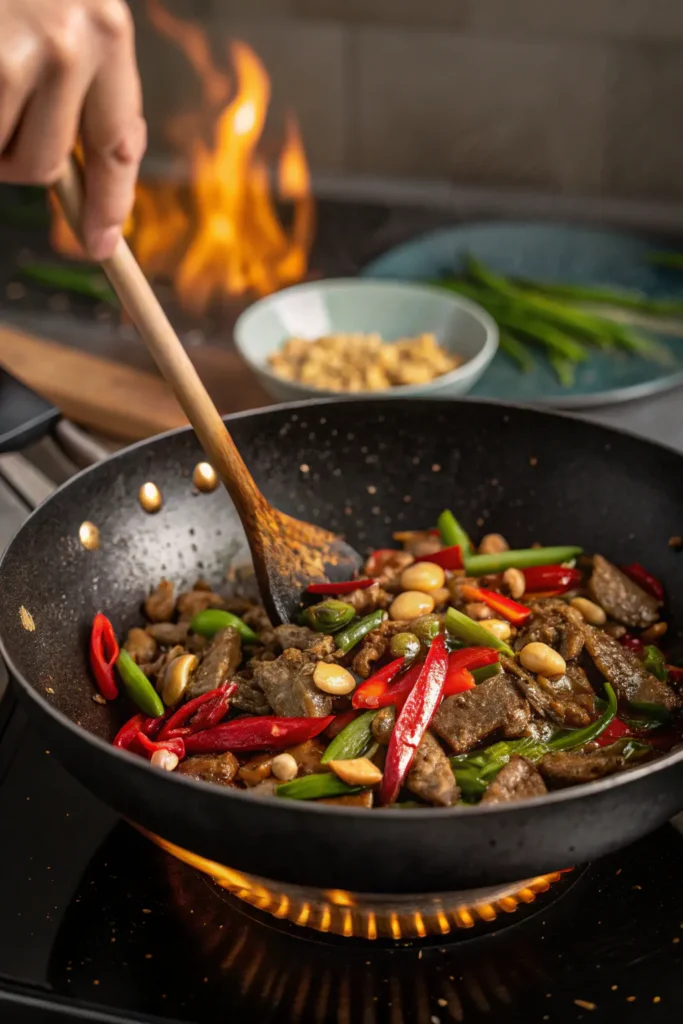
Step 1: Marinate the Beef
- Slice the beef – Cut flank steak (or your preferred cut) into thin strips against the grain. This ensures tenderness.
- Prepare the marinade – In a bowl, mix:
- 2 tbsp soy sauce
- 1 tbsp Shaoxing wine (or dry sherry)
- 1 tsp cornstarch
- ½ tsp sesame oil
- Coat the beef – Add the beef to the marinade, mix well, and let it sit for 15 minutes. This step locks in flavor and makes the beef extra juicy.
Step 2: Prepare the Sauce
In a small bowl, whisk together:
- 2 tbsp soy sauce
- 1 tbsp hoisin sauce
- 1 tbsp Chinese black vinegar (or balsamic vinegar as a substitute)
- 1 tbsp brown sugar
- ½ cup low-sodium chicken broth
- 1 tsp cornstarch (to thicken the sauce)
Set it aside—this sauce is what gives Kung Pao Beef its signature bold taste!
Step 3: Stir-Fry the Aromatics
- Heat 2 tbsp vegetable oil in a wok or large skillet over medium-high heat.
- Add dried red chilies (cut into halves) and 1 tsp Sichuan peppercorns. Stir-fry for 30 seconds until fragrant.
- Toss in 2 cloves garlic (minced), 1-inch ginger (grated), and ½ cup chopped scallions. Sauté until aromatic, about 1 minute.
Step 4: Cook the Beef
- Increase the heat to high. Add the marinated beef and stir-fry for 2–3 minutes until browned and slightly crispy.
- Remove the beef from the pan and set aside.
Step 5: Bring It All Together
- Lower the heat to medium and pour in the prepared sauce. Stir until it thickens slightly, about 1 minute.
- Return the beef to the pan, tossing it in the sauce until evenly coated.
- Add ½ cup roasted peanuts for crunch and chopped scallions for freshness. Stir for another 30 seconds.
Step 6: Serve and Enjoy!
- Transfer your delicious Kung Pao Beef to a serving dish.
- Garnish with extra peanuts, sesame seeds, and fresh cilantro for a beautiful finish.
- Serve hot over steamed jasmine rice, noodles, or stir-fried vegetables.
With this foolproof method, you’ll create a perfectly balanced, spicy, and savory Kung Pao Beef that’s better than takeout!
Pro Tips and Variations for Kung Pao Beef
Now that you’ve got the basics of Kung Pao Beef down, let’s take it to the next level! Whether you want to tweak the recipe to suit your preferences or try out a few pro tips for perfecting your stir-fry, here are some ideas to make your dish even more delicious.
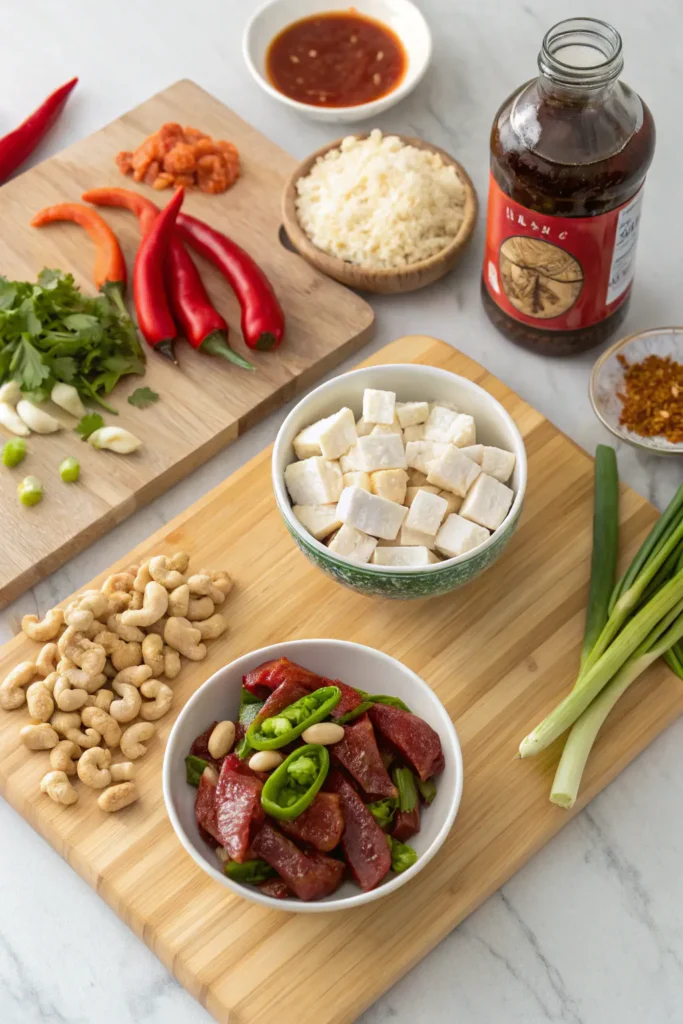
Pro Tips for Success:
- Velvet the Beef for Extra Tenderness: One secret to making your beef incredibly tender is velveting. Marinating your beef in cornstarch, soy sauce, and a little sesame oil helps create a smooth, silky texture when stir-frying. It’s a technique used in many Chinese stir-fries and ensures your meat is never tough or chewy.
- Control the Heat: Adjust the amount of Sichuan peppercorns and chili paste based on your spice tolerance. If you love the fiery heat, feel free to add more chili paste or even a few extra dried chilies. For a milder version, reduce the spice or omit the Sichuan peppercorns entirely.
- Preheat Your Wok or Pan: For the best stir-fry results, make sure your pan is really hot before adding any ingredients. A well-heated wok or skillet ensures that the beef sears quickly and doesn’t steam, keeping it juicy and tender.
- Don’t Overcrowd the Pan: Stir-frying works best when there’s enough space for the ingredients to move around and cook evenly. If necessary, cook the beef in batches to avoid overcrowding and ensure that everything gets a nice sear.
Variations to Try:
- Vegetable Boost: Add a variety of colorful vegetables to make this dish even more nutritious and vibrant. Try adding bell peppers, snow peas, or zucchini for extra crunch and freshness.
- Chicken or Tofu: For a different protein, swap the beef with thinly sliced chicken breast or tofu. Tofu can absorb all the flavors of the sauce, making it a great vegetarian option.
- Noodle Version: Turn this into a noodle dish by adding cooked lo mein noodles or rice noodles towards the end of cooking. Toss the noodles in the sauce for a hearty, comforting meal.
- Cashews Instead of Peanuts: If you prefer cashews over peanuts, swap them out! Cashews add a rich, buttery flavor that pairs beautifully with the spicy, savory sauce.
Storage Tips:
- Leftovers: If you have any leftovers, store them in an airtight container in the fridge for up to 2-3 days. The flavors actually deepen as it sits!
- Reheating: When reheating, add a splash of water or broth to bring the sauce back to life. Reheat over low heat to avoid overcooking the beef.
With these pro tips and variations, your Kung Pao Beef will be even more personalized to your taste. Get creative, and make this dish your own!
Serving Suggestions for Kung Pao Beef
Once your Kung Pao Beef is ready, it’s time to think about how to serve this delicious stir-fry for the best experience. This dish is so versatile, and there are plenty of ways to elevate it depending on your mood or the occasion. Here are a few serving suggestions that pair perfectly with this fiery, flavorful beef:
1. Serve with Steamed Rice:
A classic pairing with Kung Pao Beef is a bowl of fluffy steamed rice. The rice helps to balance out the heat and soak up all the savory sauce, making each bite even more satisfying. You can go with white rice, jasmine rice, or even brown rice for a whole grain option.
2. Add Noodles for a Heartier Meal:
If you’re craving something a bit more filling, serve your Kung Pao Beef over lo mein noodles or rice noodles. Toss the noodles in the stir-fry sauce for a hearty, comforting meal that’s perfect for dinner or meal prep. The noodles absorb all the sauce, making each bite a flavorful treat!
3. Pair with a Side of Veggies:
To round out your meal, add a side of sautéed or steamed veggies. Bok choy, snow peas, broccoli, or even baby corn make excellent choices. These veggies will complement the heat of the dish and add some extra crunch.
4. Serve as an Appetizer:
If you’re serving Kung Pao Beef as part of a larger meal, consider using smaller portions as an appetizer. Serve it in small bowls alongside other Chinese-inspired appetizers like spring rolls or dumplings. It’s a great way to start off a dinner party with a punch of flavor!
5. Garnish for Extra Flavor:
Don’t forget to garnish your Kung Pao Beef with freshly chopped scallions or cilantro. These fresh herbs brighten the dish and provide a lovely contrast to the rich, savory sauce. A light sprinkle of sesame seeds also adds a nice touch of texture and flavor.
Pro Tip:
If you’re looking to make the meal even more festive or satisfying, serve it with hot and sour soup or a refreshing cucumber salad on the side. This adds more depth to your meal and provides balance to the spicy flavors of the Kung Pao Beef.
With these serving ideas, you can make your Kung Pao Beef the star of the meal or a perfect side dish that complements other flavors. It’s as versatile as it is delicious, and you’ll be sure to impress your guests or family with every bite!
More Delicious and Easy Asian Recipes You Will Love
If you’re a fan of Kung Pao Beef, there’s a whole world of delicious, easy-to-make Asian dishes waiting for you to explore! Here are some more recipes that are just as flavorful, satisfying, and simple to prepare at home. These dishes will help you expand your cooking repertoire while enjoying the vibrant flavors of Asian cuisine.
1. Sweet and Sour Chicken
If you love that perfect balance of sweet and tangy flavors, Sweet and Sour Chicken is a must-try! Crispy battered chicken tossed in a vibrant, tangy sauce made with vinegar, ketchup, and sugar offers a delightful contrast to the savory Kung Pao Beef. It’s the ultimate comfort food that’s sure to be a hit with family and friends.
2. Beef and Broccoli Stir-Fry
For a lighter, veggie-packed option, Beef and Broccoli Stir-Fry is an excellent choice. Tender beef and crisp broccoli in a savory garlic sauce make this dish both healthy and hearty. It’s a great companion to your Kung Pao Beef, especially if you want a meal that’s still full of flavor but lower in heat.
3. Thai Basil Chicken (Pad Krapow Gai)
This dish brings the heat and aromatic flavors of Thai cuisine right to your kitchen. Pad Krapow Gai is made with ground chicken stir-fried with Thai basil, chili, and garlic in a salty-sweet sauce. If you love spicy, herby, and fragrant dishes like Kung Pao Beef, this is a recipe you’ll want to try next!
4. Teriyaki Salmon
If you’re craving something a little lighter but still packed with flavor, Teriyaki Salmon is the way to go. The rich, savory teriyaki sauce perfectly complements the juicy, tender salmon. It’s a perfect alternative for those who prefer seafood over beef and want a quick, healthy dish.
5. Vegetable Fried Rice
Looking for a perfect side to pair with your Kung Pao Beef? Vegetable Fried Rice is quick, easy, and loaded with flavor. This dish features rice, mixed veggies, and savory soy sauce for a comforting, satisfying addition to any meal. You can also add scrambled eggs or your choice of protein to make it a complete dish.
Your New Favorite Recipe – Kung Pao Beef
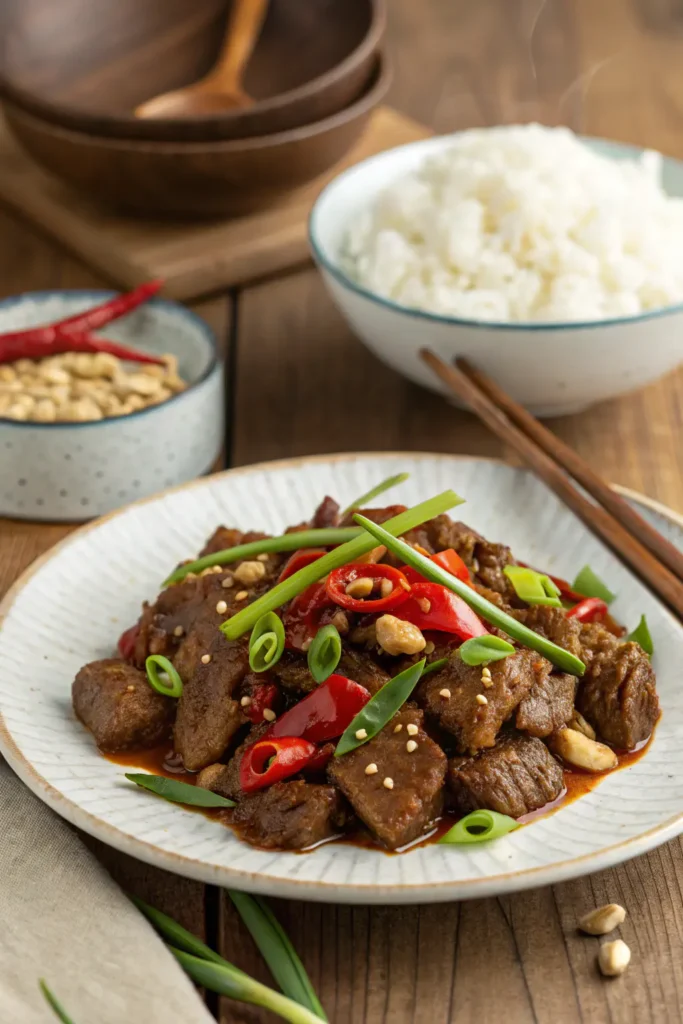
Congratulations, you’ve just created a dish that’s bursting with bold flavors and fiery heat – your very own Kung Pao Beef! Whether you’re cooking for a weeknight dinner, hosting friends, or meal prepping for the week, this recipe offers an easy yet restaurant-quality stir-fry that will impress everyone at the table.
This recipe is all about balance: tender beef, vibrant veggies, crunchy peanuts, and that addictive sauce that brings together savory, sweet, and spicy flavors. It’s the perfect dish to master if you love Chinese-inspired cooking and crave something that’s both satisfying and exciting to eat.
Happy cooking, and enjoy the bold flavors you’ve just brought to life in your kitchen!
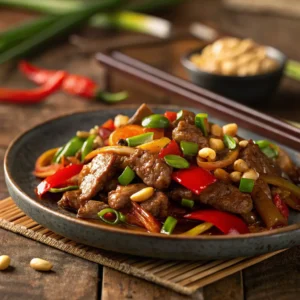
Kung Pao Beef
Ingredients
For the Marinade:
- 1 lb flank steak or sirloin, thinly sliced against the grain
- 2 tbsp soy sauce
- 1 tbsp rice vinegar
- 1 tbsp cornstarch
- 1 tsp sesame oil
For the Stir-Fry Sauce:
- 2 tbsp soy sauce
- 2 tbsp hoisin sauce
- 1 tbsp Chinese black vinegar or substitute with balsamic vinegar
- 1 tbsp sugar
- 1 tsp Sichuan peppercorns ground (for that signature numbing flavor)
- 1 tsp chili paste adjust to your spice preference
- 1 tsp garlic minced
- 1 tsp ginger minced
For Stir-Frying:
- 2 tbsp vegetable oil or peanut oil for an authentic touch
- 1/4 cup dried red chilies use more or less for your desired spice level
- 1/2 cup roasted peanuts
- 1 bunch scallions chopped (for garnish)
Instructions
Step 1: Marinate the Beef
- Slice the beef – Cut flank steak (or your preferred cut) into thin strips against the grain. This ensures tenderness.
- Prepare the marinade – In a bowl, mix:
- 2 tbsp soy sauce
- 1 tbsp Shaoxing wine (or dry sherry)
- 1 tsp cornstarch
- ½ tsp sesame oil
- Coat the beef – Add the beef to the marinade, mix well, and let it sit for 15 minutes. This step locks in flavor and makes the beef extra juicy.
Step 2: Prepare the Sauce
- In a small bowl, whisk together:
- 2 tbsp soy sauce
- 1 tbsp hoisin sauce
- 1 tbsp Chinese black vinegar (or balsamic vinegar as a substitute)
- 1 tbsp brown sugar
- ½ cup low-sodium chicken broth
- 1 tsp cornstarch (to thicken the sauce)
- Set it aside—this sauce is what gives Kung Pao Beef its signature bold taste!
Step 3: Stir-Fry the Aromatics
- Heat 2 tbsp vegetable oil in a wok or large skillet over medium-high heat.
- Add dried red chilies (cut into halves) and 1 tsp Sichuan peppercorns. Stir-fry for 30 seconds until fragrant.
- Toss in 2 cloves garlic (minced), 1-inch ginger (grated), and ½ cup chopped scallions. Sauté until aromatic, about 1 minute.
Step 4: Cook the Beef
- Increase the heat to high. Add the marinated beef and stir-fry for 2–3 minutes until browned and slightly crispy.
- Remove the beef from the pan and set aside.
Step 5: Bring It All Together
- Lower the heat to medium and pour in the prepared sauce. Stir until it thickens slightly, about 1 minute.
- Return the beef to the pan, tossing it in the sauce until evenly coated.
- Add ½ cup roasted peanuts for crunch and chopped scallions for freshness. Stir for another 30 seconds.
Step 6: Serve and Enjoy!
- Transfer your delicious Kung Pao Beef to a serving dish.
- Garnish with extra peanuts, sesame seeds, and fresh cilantro for a beautiful finish.
- Serve hot over steamed jasmine rice, noodles, or stir-fried vegetables.
Notes
Nutrition Information (Per Serving)
- Calories: 350
- Protein: 28oz
- Carbohydrates: 18oz
- Fat: 18oz
- Saturated Fat: 4oz
- Cholesterol: 0.002oz
- Sodium: 0.027oz
- Fiber: 2oz
- Sugar: 6oz
FAQ
Is Kung Pao Beef Healthy?
Kung Pao Beef can be made healthier depending on your ingredient choices. To reduce calories, you can use lean cuts of beef like flank steak or sirloin, and you can also swap out the peanuts for a lower-calorie option like cashews. If you’re watching your sodium intake, opt for a low-sodium soy sauce and control the amount of sugar in the sauce. Overall, this dish is a flavorful option, but like most stir-fries, it’s best enjoyed in moderation as part of a balanced diet.
What is Chinese Black Vinegar?
Chinese black vinegar is a staple in many Chinese dishes, offering a deep, complex flavor profile that’s a bit more robust than regular vinegar. It’s made from rice and aged to create a tangy yet slightly sweet taste with a hint of smokiness. It’s essential for many stir-fries and dipping sauces, adding depth to dishes like Kung Pao Beef. If you can’t find it, you can substitute with balsamic vinegar or a combination of regular rice vinegar and a touch of sugar.
What is the Difference Between Kung Pao Beef and Mongolian Beef?
While both dishes are beloved in Chinese-American cuisine, Kung Pao Beef and Mongolian Beef have distinct flavors. Kung Pao Beef is known for its bold, spicy, and slightly sweet sauce, with the signature addition of Sichuan peppercorns for a tingling heat. Mongolian Beef, on the other hand, features a sweeter, soy-based sauce without the spice, and it’s typically paired with onions and green onions. If you love a kick of spice, Kung Pao Beef is the way to go!
What Does Kung Pao Taste Like?
Kung Pao Beef has a perfect balance of savory, sweet, and spicy flavors. The soy sauce and rice vinegar provide a savory base, while the sugar adds sweetness. The heat comes from chili paste or Sichuan peppercorns, which give the dish a unique tingling sensation. Paired with the crunch of peanuts, the texture and taste of this dish are truly irresistible.
What is Kung Pao Made Of?
The classic ingredients in Kung Pao Beef include thinly sliced beef, soy sauce, rice vinegar, Sichuan peppercorns, chili paste, peanuts, and vegetables like bell peppers and onions. These ingredients come together to create a savory, tangy, and spicy stir-fry that’s packed with flavor.
Is Kung Pao Really Spicy?
Yes, Kung Pao Beef can be spicy! The level of heat is determined by the chili paste and Sichuan peppercorns used in the recipe. If you’re sensitive to spice, you can adjust the amount of chili paste or skip the peppercorns to make the dish milder. For those who love a bold kick, feel free to add extra heat!

